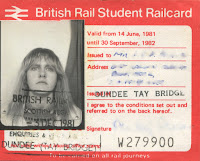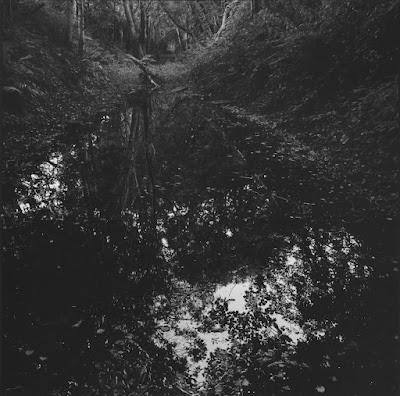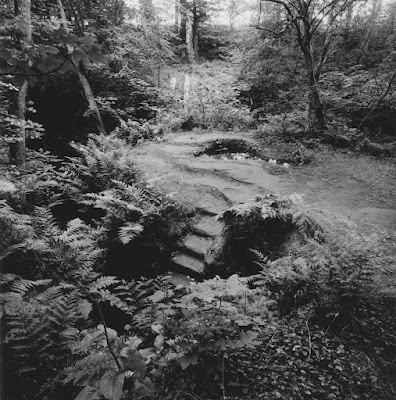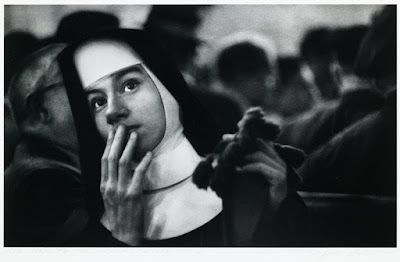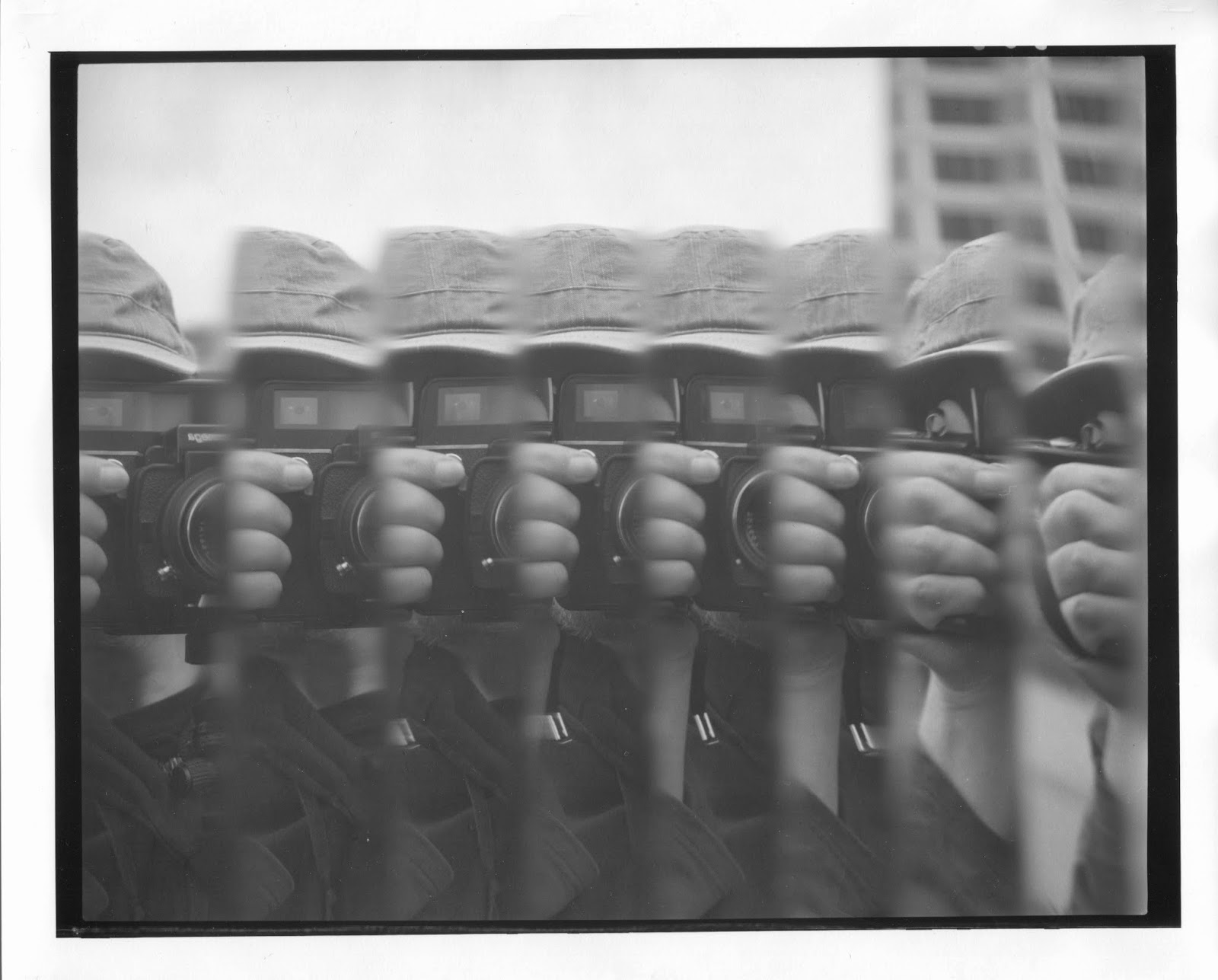(Started in August 2021, and please beware, because it is probably controversial, daft, thick, thought-provoking [?], polemic, opinionated, wrong, true, interesting and dull all at once. It is also a long read, so be prepared with provisions and a rescue team just in case)
Morning folks - hope you are all a rootin' and a tootin'!
This post is an interesting one, because as I start typing I have no idea where I am going, and no idea what (if any) conclusion or usefulness will come out of it; however as is often the case, I find the keyboard to be as valuable as a psychiatrist's couch, so please bear with me whilst I set the slurry lorry on flick and get spattering all that lovely watery cowy goodness out the back whilst pootering along this particular field.
Putt, Putt Putt . . .
Splat, Splat, Splat . . .
 |
| Battling Glare, Darkness, Spotlights, Full Aperture And A Handheld One Second Exposure, The M2/Summaron Combo Delivers The Goods . . . Weirdly. Proudly Unchimped. |
Me and t'missus settled down to watch something we'd recorded off BBC 4 a while back:
Rankine's Photography Challenge.
I was excited; it isn't often photography is featured on TV, so this was somewhat of an event.
I munched my Lidl's Digestive and sipped my cup of really rather strong coffee and was genuinely waiting to be wowed.
Cooo!
Here were the candidates, all fresh faced and toting really not inconsiderably expensive cameras.
There was a young lad describing how he'd sleep in carparks in order to catch a sunrise; an older bloke with PTSD who said that wildlife photography had saved his life.
I noticed there were others; a healthy mix of all genders, very woke and PC, but to be honest by this stage I'd mentally switched off.
Why?
Well amongst the pontificating of:
"That's The ONE!"
"I'd be proud of that!!"
"Get down on the ground and shoot it from there!!!"
"Coo, you don't get many of those to the pound!"
(Made that last one up actually) something in me had begun to feel really rather sick.
There were about a billion shutter activations in the first fifteen minutes.
Studio flashes like miniature atomic space battles.
People 'chimping' left right and centre.
Kids putting themselves in shutterly inappropriate positions - the way people mishandle handguns in films (you know, loose wrist, pointed sideways) - camera as an extension of forearm.
It was snappy, overloaded and packed to the gunwhales with jaunty camera angles and semi-shouty presentation to make it look interesting, and sadly, like two Cokes plus a kilo of candy-floss plus several spins on The Sickener, this fairground ride made me feel the way I always feel at fairs:
Queasy with a capital Q.
So I turned to the missus and said:
'Can we watch something else?'
And that was a shame, it really was, because these people were buzzing with photography.
They were truly enthused.
To coin a certain Mancunian phrase from decades ago, they were:
Mad For It.
I wished them well, bade them good luck and with a heavy heart and a sick bucket, switched to something else.
The "something else" was a program which is still in my head.
It was a BBC documentary about Lee Miller.
What an extraordinary life, however it was her contact prints from the liberation of Dachau and Buchenwald which left a mark. Though not shown closely, what she said in the frames taken with her Rolleiflex said oceans more than a million digital spray jobs.
And then, the fact that said experience made her pack away all her negatives and prints and not talk about it for years, speaks volumes about how much of herself she put into taking those photographs.
And also how much those photographs took out of her.
You can find out more about her here.
The following night, just because, we watched a documentary about Ansel.
To say the guy was driven, would be a slight.
These days you'd probably say he had OCD.
It came as no surprise that the huge channeling of human spirit, energy and sheer effort that went into the taking of every negative and the making of every print, came about as a result of methodical obsession.
I believe this could only ever have been achieved with film and paper.
He would never have been able to internally and externally transition the piece from "score to orchestra"' (negative to print) with some photoshop moves and an inkjet printer.
Absolutely no way José.
To watch him dodging and burning was like watching the poetry of great dance or, dare I say it, football.
It was transfixing, assured and magical all at once.
A master class in craft skills and second nature.
It was definitely not the nurdling around of a mouse and cursor and ordering some 1's and 0's to:
"Do THAT!"
It was not some old geezer checking his screen after every shot.
I thought about it and was so stunned by the apparent dissolve between these masters and what passes for photography in this digital age that I had to investigate further.
It will come as no surprise that You Tube is a tremendous source of old photographic documentaries.
Name the crafts-person (gotta be PC y'know) from a bygone age and you'll probably find something about them on there in some form.
From the classic Parkie-style interview, to decent overviews.
And it is weird because you'll see the overlaps too - great photographers who have gone over to the Light (room) side like it means little to them.
Yet I truly feel something has been lost, and in that loss lies a blackhole that is at the centre of current photography:
The photographer as printmaker.
Bill Brandt (BBC Master Photographers) was a revelation to me.
I only really knew Bill from a handful of photographs, but in this programme there were countless great images - so stylistic and austere, yet better than anything I have seen produced in 'modern' times.
To paraphrase a conversation in the programme:
Interviewer: "Mr. Brandt, you always do your own printing don't you?"
BB: "Oh yes."
Interviewer: "It is very important to do one's own printing?"
BB: "Yes, definitely, very important, yes . . . because I change pictures completely in the darkroom . . . most of the work is done in the darkroom . . . "
 |
| © Bill Brandt Estate |
André Kertész? The poet who wasn't technical enough for the American Photography Scene (apparently).
Whilst enamoured with polaroids (technically geeky I suppose) at the end of his life, he produced numerous beautiful images which were all the more perfect for their imperfections.
I couldn't imagine him chimping at his Canon's screen - he knew exactly what the photograph he had taken would look like. How's that for confidence and skill?
The post-digital world of perfect, everything in focus from 3" to infinity and then HDR'd to the hilt, would I think have left him cold.
Look at this.
 |
| © André Kertész Estate |
It truly is exquisite in colour, composition and form.
A simple sculpture and mirror in his apartment and a piece of Polaroid film.
OK, the smelly wet stage of printmaking was taken away (although remember the 'orrible caustic stuff you use to get with Polaroids . . hmmm) but it is still a print and besides, he'd earned his stripes for decades.
The colours on the Polaroid are ageing in a way like the patina on a piece of Bronze Age metalwork - it is beautiful.
Delving deeper and randomly, I came across a documentary about the British photojournalist Tim Page.
A young man, leaves home at 17; travelling he picks up a camera and gets somehow caught up in Vietnam!
It is an old BBC Arena called "Tim Page - Mentioned In Despatches".
Unlike other war photographers I have seen, who have dealt with the aftermath in more stoic ways, Tim (in the documentary) seemed to be that same young man fresh from combat, frozen in time, back in civi-street, recovering from debilitating war injuries, trying hard to find something to hold onto to keep him from drowning in the downright ordinariness of 'normal' life.
He finds some solace in photographing an RAF camp filled with Vietnamese Boat People - there he truly looks at home.
In his local Charrington pub, quaffing a pint of Charrington's Best Bitter (or so it looked) and smoking a fag, he looked pensive, evaluative; to be frank, out of sorts as they say.
In the documentary he replies to a question (in a Q&A session) about carrying a gun, and explains, that he never really did because guns are heavy, especially when you are carrying 4 cameras, 6 lenses and 50 rolls of film.
50 rolls - 12 or 1800 images as if your life depended on it.
Finite.
They had better count.
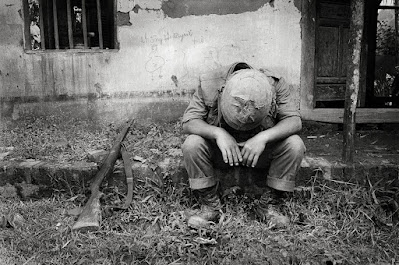 |
| © Tim Page |
And man did they count.
Look at the above - one image that sums up the human cost of war. No corpses, but the young man's demenour says more than anything I have ever seen.
If it were digital, there'd be screeds of images, the scene would have been sprayed, broadcast live to a news feed, looked at once and probably forgotten.
And yet here, Tim's skill and eye have rendered the cost, visible on one perfect frame of film; one perfect print.
That's photography.
He took pictures like he was never sure whether he'd be coming back; fearless.
Negatives, slides.
I found his images incredibly hard to look at, and yet, to paraphrase him:
". . . there is a lot of Asian softness in them."
You should watch it.
His website is here.
I could go on about the documentaries, but I won't - you owe it to yourself to find them.
It isn't hard.
The above is the merest skirting of the subject though - get looking and thinking.
Dipping on further and looking at my small collection of books, I came to the conclusion that it is the finite quality of traditional photography which defines it.
You take a picture, process it, print it, file it.
It is a one-off artefact - even manipulated via multiple negatives (a la, say, Julius Shulman's astonishingly beautiful architectural photographs) and all the work done in a darkroom to bring it to completion.
If you have never encoutered Shulman and you love black and white (and buildings) you owe it to yourself to seek them out - they're really fantastic.
 |
| © Julius Shulman Estate |
This was apparently a composite of three negatives, nevertheless it is wonderful.
The skill involved at all stages to get to the final print is breathtakingly complex.
The printer's skill has not been outsourced to a computer.
The print becomes the full stop on the image.
The image defines the moment.
Yet I don't think it's really like that anymore.
You might well disagree with me, but to my mind it really isn't.
Have a break - have a Kit Kat.
Aaah, that's better!
I understand there are many concerned and committed photographers out there taking important pictures and I have nothing but respect for them, but the digital rendering is to my mind just convenience.
It is the 'norm'.
Everybody else is doing it so why don't we?
You possibly even have little choice with editors and picture people on your back wanting something yesterday.
You can whizz that important image around the world in nano-seconds.
There is no waiting whilst you send your films back to an ever-awake processing department.
There is no wait whilst you close the door on your darkroom and sweat.
The screen has become the pseudo-print, but rather than that print being put aside in a pile, or brandished in a breathless run to show someone, your image is now a collection of part-remembered photons in your mind's eye.
Scrolled by contemporaries . . .
In the words of Alex Harvey:
"N. E. X. T. . . Neeeeexxxt!"
And it isn't just to do with how your precious image is stored and presented either; film and digital, obviously they are both utterly different, but to tie things in with my original ride on The Sickener from the top of this 'ere page, it's the sheer ease with which everything can be done.
There used to be an expression 'kicking against the pricks' - whilst the usual interpretation is about authority, I have always thought of it as something that ties in with art.
Art is struggle.
Photography used to be a struggle.
To my mind though, in ALL creative pursuits, struggle can be beneficial.
You strive to do better.
I remember once walking for miles, taking many (so I believed) fine photographs, only for said photographs to be rendered null and void by expired developer.
It is a thing you only do once.
It informed me.
It made me a more careful craftsman.
With digital, you no longer have that.
You check every single bloody image.
Make sure it is perfect on the spot. Just watch the news!
You delete those that you don't like and yet, to quote Tim Page:
"Every day is an assignment. Every picture you shoot, even be it an idle snap; I'm using the word snap, in a sorta very loose context.
The snap is gonna be valuable."
Snaps are gone with digital - eradicated by the monkey-move and the editorial thumb.
You could argue that the plethora of idle phone pointing that goes on, is the snap.
Well yes, I can see how you come to that, except they're not really, simply because they only exist on a screen.
They will never be gripped and looked at again; beery, smoky, greasy fingers will no longer leave their mark. Spitty crumbs of laughter will not mar their perfection.
(As an aside I'll draw your attention to The Anonymous Project - a laudable collection of old slides - their like will never be seen again.)
In my family, we still sometimes drag out prints and snaps from decades ago and laugh and talk and reminisce - it is a wonderful, unexpected and oft overlooked aspect of being a (semi-modern) human.
Who would have thought, when photography was first being developed and people had prints made for relatives, as keep-sakes, records of their lives, that those simple (yet vastly complex) pieces of time would come to define their lives?
Identity was established; some kind of social grace was incurred - all dolled up in your Sunday Best, and thence on to the snap, the wonderful delineation of humankind in all its incredible variety.
Look at at the above - a chance physical find whilst doing some tidying.
That's me in a photo-booth 40 years ago!
A close relative to Kertész' polaroids, technology wise.
It exists in the world.
It isn't a collection of data lost on some hard-drive, or more likely, deleted as no longer relevant.
Can you see where I am going?
Far from furthering an art-form I love; far from moving it forward, I feel that creatively and archaeologically, digital has pretty much killed 'photography' (as I know it) stone dead.
Cuddle up with that phone and scroll through all those pictures - oh can I see that one with the rubber chicken?
Oh shit, where the heck is it?
Och God I can't be arsed . . . .
But then maybe that is just me.
A rank amateur living on the East coast of a very small country - what do I know?
I'll bet most people disagree with me.
But I look around (a lot); I trust my eyes and my observation of quality and bog-standard snappery from ages past, and I see little now that surprises or impresses or pleases me.
What a feckin' B.O.F. eh!
And then there was a pause during which yer author rubbed his chin and thunked.
Re-reading the above a month or two later, I decided I was being too polemical, too pontificating and too downright opionionated, so I decided to put some distance between me and 'it' and see how I felt a while later.
So, a month or so later:
I feel that what I wrote makes me sound like an arse.
What right have I to pass judgement on one of the world's most popular hobbies?
How can I stand here and say that truth is no longer what it used to be?
You could argue that photographically truth was never what it was.
I can totally see where you are coming from.
And yet, I can't quite put the way I am feeling about the current state of photography into words.
Maybe it has always been thus.
Millions of images, with maybe one in hundreds of thousands that makes you go:
'OH!'
There currently seems to be no end to the massed ranks of clamour; of images made for pleasure, purpose, or mostly, so it seems, just because you can.
The digital image knows no boundaries, and I don't mean in the creative sense, I mean it in the sense that it is an ever-expanding frontier of data assembled into pictures.
There is no physical limit simply because you don't really need to think like that anymore.
You are not going into a combat situation with 50 rolls of film.
You are not limited by the physical length of a roll.
The sky is the limit, and even then . . .
Even the most careful digi-photographers I know complain endlessly about the sheer amount of stuff they have.
It is archived and filed and amassed on hard drives or clouds, and it sits there by the myriad, consuming energy in a pointless waste of storage, because nothing will ever happen to photo #15 of the 300 you took of your children playing ball.
You really won't make that nice picture of a daisy (in macro-mode) into a nice picture for your partner.
IT IS FACT - YOU SIMPLY WON'T.
They say that traditional photography was environmentally unfriendly in its use of chemicals and resources, but I conject that digital photography is far more unfriendly simply in its power usage.
Not only that but the traditional photograph impacts environment relatively quickly: a release of noxious chemicals, the results filed away and delved into occasionally; but that is it, the results are yours. Of course you have to factor in the silver mining and plastic production, but counter that with rare earth metals in every camera battery, the plastics in every SD card.
And you've got to think about the trillions of digital images stored on servers; all drawing energy for their storage whether viewed or not, usually not.
Some are printed, but they're still stored on physically ultimately fragile devices like hard drives or flash media or SD cards - future landfill.
Of course on the other hand they could also (unwisely) only be stored on cloud storage, where they are entirely at the behest (unpaid, or peppercorn-rent guests as it were) of digital flop-houses.
An uncertain future! For should owners of said digital flop-houses maybe start charging considerably more, because of power costs, because of hunger for more dosh, for whatever reason, what then happens to a visual history of the latter half of the twentieth, early part of the twenty-first century?
Yep:
"Oh that old picture, nah, not going to pay for that."
"I've got another 30 of the kids, forget about that one."
Look how truly fragile this digital world really is.
I know we could sit and argue this till the cows come home - maybe you should come around sometime and we could head to the pub.
All of the above reads like it was written by someone who at a certain time of life has become thoroughly entrenched in their thinking and has no wish to look over the parapet.
Strangely, I wouldn't blame you for thinking so, but also, I wouldn't count myself as one of those.
I am open to argument, but I also know what I like and what I think, and if you are from 'the other side' as it were, my salutations to you - I am not taking a pop, just providing a different slant on what you'll see elsewhere. Hopefully it will make you think about the physical/un-physical fragility of the modern world.
To be honest, my bias towards so-called 'traditional' photography is as firmly entrenched as an old wellie in a huge pool of cow shit.
You might be able to extract me, but it would be incredibly messy for both of us.
Best let entrenched boots lie, eh?
To round things off, the above is a perfect example of why, like Tim Page says, the snap matters.
This was a 'snap' with a Hasselblad SWC/M.
The light was sort of like that - heavy cloud cover and a brief bit of liquid sunshine hitting the path making the stones really stand out.
I did print the sides down slightly (in a poor fashion) but on the whole it was pretty much like that.
It has sat as a scrap in my darkroom for a year or so. I never ditched it, just used it for setting print borders.
Now I come to look at it properly, I like it.
Had it been digital I would probably have deleted it at the time.
Not saying, just saying . . . .
As I finish, I'd like to say that really, I know none of you, however if you are a printmaker, I tip my tifter to you - you're keeping something vital alive, and if you don't run a darkroom but get other people to make prints from your negatives, I tip my hat to you too, because you're producing something physical.
If you're a squirter (sorry - that's my own nomenclature) well at least you are printing, but as far as I am concerned, it really isn't the same. The skill set is vastly different.
This being said it doesn't NOT make you a photographer, it's just a shame that the world of modern photography has been skewed away from something that was always its beating heart - THE DARKROOM.
If all you ever view is screens, think again - it is worth the effort to try and change that. Buy a modern Polaroid camera and go and have fun - it will transform the way you feel about making images, and the Polaroids will probably outlast you as well - something for future times. A present from the past.
That's it - thank you for reading once again.
Take care, be safe and watch out for the normal people.
